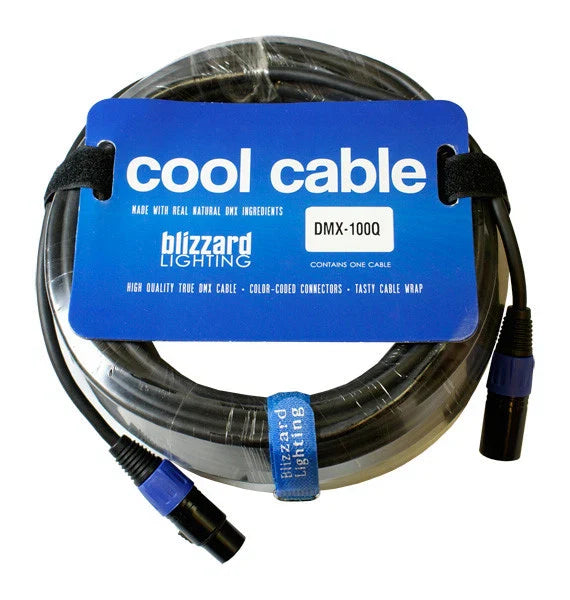
Future of Stage Lighting: Why DMX Lighting Cables Are Still the Backbone of Modern LED Systems
Share
In the world of stage productions, concerts, and live events, technology continues to evolve at a rapid pace. LED systems have transformed the way we design and experience stage lighting. Yet, one thing remains constant: the backbone of these systems is still the DMX lighting cable. Despite the rise of wireless technology, stage lighting cables play a critical role in ensuring stability, precision, and reliability.
For professionals searching for lighting cables and accessories, investing in high-quality DMX cables for lighting ensures smooth communication between controllers and fixtures. Without them, even the most advanced lighting systems could fail at crucial moments.
Explore our collection of DMX Lighting Cables and Accessories to see the latest options for your stage setup. All of Blizzard's DMX cables come with a Lifetime Limited Warranty
Why DMX Cables Remain Essential in Modern Lighting
DMX, or Digital Multiplex, is the industry standard protocol used to control lighting fixtures. While wireless options exist, DMX cables remain the most reliable medium for transmitting signals across stage lighting systems.
Here’s why:
- Consistency – Unlike wireless signals, DMX cables don’t suffer from interference.
- Accuracy – They provide stable data transfer to ensure lighting changes happen exactly as programmed.
- Durability – High-quality LED lighting cables are built to withstand touring, live events, and permanent installations.
Answering Common Questions About DMX Lighting Cables
1. What is a DMX cable and how is it different from an audio (XLR) cable?
Although DMX and audio cables both use XLR connectors, they are not the same. Professional grade DMX cables meet the USITT standards for DMX512 cable specifications - 120 ohm characteristic impedance, low capacitance, and double (foil and braid) shield and should be exceptionally durable and have flexible construction.
Reliable Data Transfer
Unlike microphone cables that are not intended for data transmission, these cables offer reliable transfer through their data-specific design, and wire that is wrapped 5x tighter than XLR cables. Plus, they feature a durable jacket that remains flexible in hot or cold temperatures.
DMX cables are designed with 120-ohm impedance and proper shielding for digital data transmission, whereas microphone cables are built for analog signals. Using the wrong cable can lead to signal loss and unpredictable lighting performance.
2. Can I use a microphone cable (or audio XLR) for DMX lighting?
It’s a common mistake, but not recommended. While some systems may temporarily function with an audio cable, it often leads to flickering lights, inconsistent signals, and possible equipment damage. Always choose DMX-specific stage lighting cables for reliable performance.
3. Why is proper shielding and impedance important in DMX cables?
DMX systems rely on precise digital communication. Proper shielding prevents external interference, while 120-ohm impedance ensures the signal travels accurately across the chain of lights. Without this, your show’s lighting effects may fail during live performances.
4. What’s the difference between 3-pin and 5-pin DMX connectors?
Both types are widely used in the industry.
- 3-pin DMX cables are common in smaller setups and affordable fixtures.
- 5-pin DMX cables are the official industry standard, offering two extra pins for advanced data signals.
Choosing between them depends on your setup, but always match your equipment’s specifications to the correct connector type.
Key Benefits of Choosing the Best Lighting Cables
- Signal Integrity – Prevents flickering and ensures accurate lighting cues.
- Longevity – Durable materials withstand bending, foot traffic, and repeated use.
- Compatibility – Designed to work with all DMX-compliant lighting systems.
- Scalability – Allows multiple fixtures to be daisy-chained without loss of performance.
Whether you need stage lighting cables for a concert, theater, or corporate event, investing in the best lighting cables ensures professional-quality results.
Beyond Stage Lighting: Other Uses of DMX Cables
Though primarily associated with stage productions, DMX cables are also used in:
- Architectural lighting installations
- Nightclubs and DJ setups
- Large-scale LED displays
Some professionals even refer to them as lighting cable aux connections, bridging multiple fixtures for synchronized effects.
Choosing the Right DMX Lighting Cables and Accessories
When browsing for lighting cables and accessories, consider the following:
- Cable length – Based on your specific application needs
- Connector type – Match 3-pin or 5-pin connectors to your fixtures.
- IP65 Rated- IP Rated DMX cables are also available in 3-pin & 5-pin version based on your specific fixture requirements.
- Build quality – Look for reinforced connectors and flexible jackets.
- Brand reputation – Trusted manufacturers ensure consistency and safety.
Browse our full range of DMX Lighting Cables and Accessories designed for professional use.
FAQs About DMX Lighting Cables
Q1: Can I substitute an audio cable for DMX?
Not recommended, always use DMX-specific cables to prevent signal loss and interference.
Q2: Which is better—3-pin or 5-pin DMX cables?
Both work, but 5-pin follows industry standards for advanced setups. Your fixtures will dictate which connector end you use.
Q3: Why does impedance matter in DMX cables?
It ensures accurate digital signal transmission without errors.
Q4: Are DMX cables only for stage lighting?
No, they’re also used in Hosuses of Worship, architectural lighting, clubs, and LED installations.
Q5: How do I know if I’m buying the best lighting cables?
Look for professional-grade materials, strong shielding, and reliable connectors.
